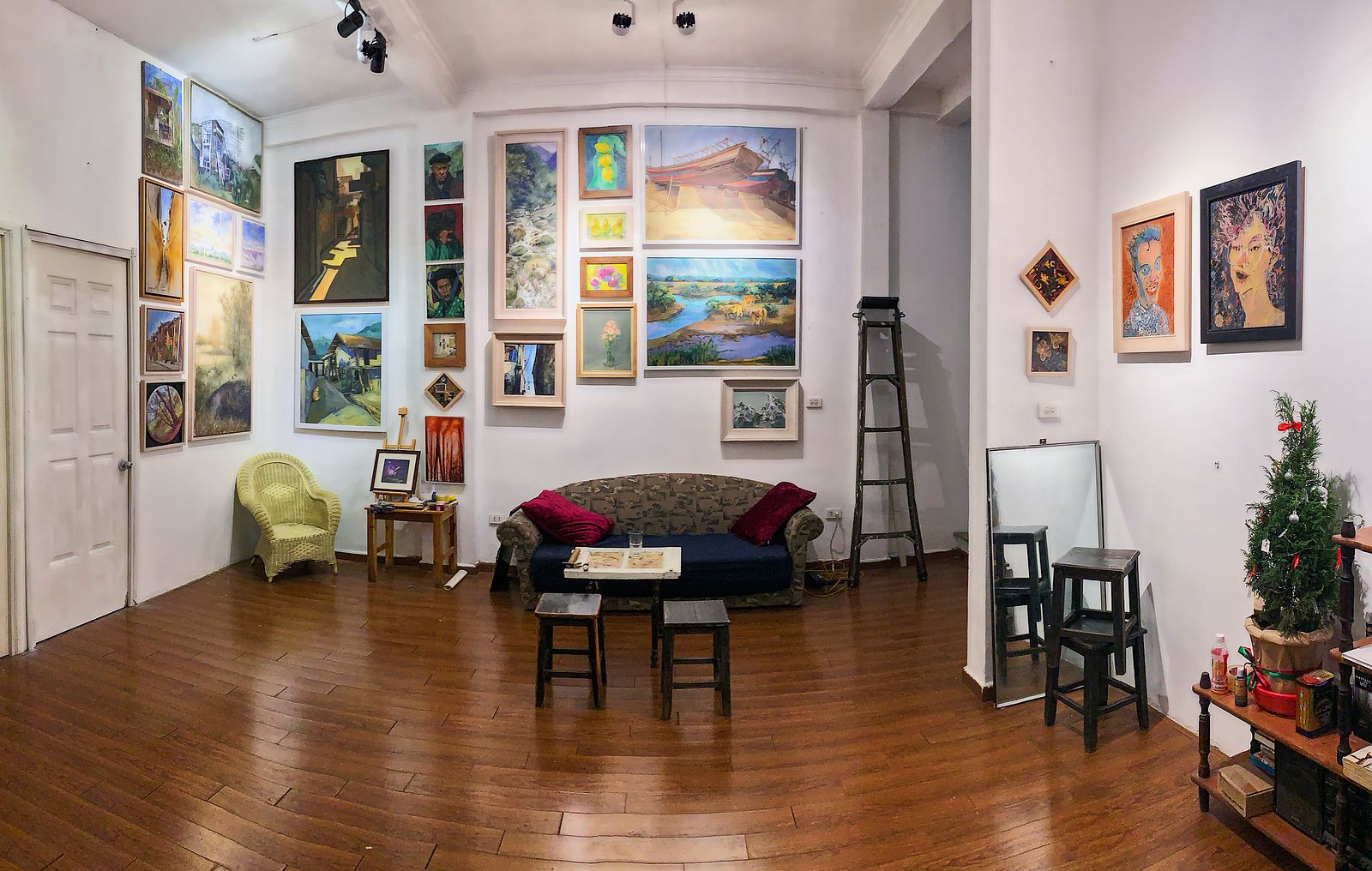As she approaches her 90th spring, artist Mộng Bích continues to paint with insatiable gusto and infectious calm in preparation for her solo show at the French Institute of Hanoi opening on October 22, 2020.
The exhibition titled, “Entre Deux Siècles” (Between Two Centuries), was the first major study of the artist's work bringing together paintings, sketches and studies, all narrated by Bích through accessible audio clips. The works span from the 1960s to the present day, recounting her experiences across the country through the lens of her uniquely sensitive and caring eyes. Director of French Institute of Hanoi Thierry Vergon tells Saigoneer: “Mộng Bích's work has crossed the generations without losing its identity. It alone constitutes an original testimony to the sometimes painful times that Vietnam went through, and which have forged today's society.”

'Em bé Hàn Quốc' by Mộng Bích. Image via VOV World.
Born to a family of intellectuals in 1931 in Dong Ngac, north of Hanoi, Bích was inspired by her brother and his artist-architect friends, wishing to become a painter from a very young age. From 1945 to 1946, during the war against the French, Bích’s father left for a mission by order of the Ministry of Education and the rest of the family was evacuated to the region of Doan Hung. After the liberation of the capital in 1954, she returned to Hanoi to work for two years at the Central Armistice Committee and began art lessons with Diệp Minh Châu. In 1957, she, along with a fresh cohort of selected students, studied painting at the newly reestablished Vietnam Fine Arts School — previously the École Supérieure des Beaux Arts de l’Indochine founded in 1925 by the French, and currently the Vietnam University of Fine Arts.
The university had survived many years of turbulence since its inception after the August Revolution of 1945, where it was named by the provisional government as one of the first of eight higher education institutes to open. Tô Ngọc Vân held the role of principal; however, they were only in function one year before resistance truly broke out, and the revolutionary government had to withdraw to the war zone. When the Resistance War entered its 5th year, Tô Ngọc Vân had managed to convince his leaders to move the art school to the resistance zone in Viet Bac.

Mộng Bích in the garden of her home in Bac Ninh. Photo by Bùi Hoài Nam Sơn.
The school functioned under extremely difficult circumstances, its 22 students studying in ad hoc settings with whatever materials they had on hand. Moving three times from Yen Da to Nghia Quan and finally An Phu, where it remained until 1954 the year of the Battle of Dien Bien Phu. In the same year, to the great grief of the artistic community, Tô Ngọc Vân passed away.
As the country came to terms with the ramifications of the battle, those that were able to relocate, including many of the arts students and professors, returned to Hanoi. The school eventually regrouped under the newly appointed direction of painter Trần Văn Cẩn and the permanent campus opened its doors in 1957. Bích was part of these first students of the Hanoi cohort. Her friends include Nguyễn Tiến Chung, Lê Thị Kim Bạch and Nguyễn Thanh Ngọc. The famously stellar generation of both male and female artists, many of whom moved onto having prolific careers, are cited as having a huge influence on the development of Vietnamese art history, particularly in painting.

Mộng Bích painting a still life at home earlier this year. Photo by Bùi Hoài Nam Sơn.
In Bích's case, however, her student years were not carefree: like many during the post-war era, Bích worked odd jobs during the evenings while she cared for her husband, a professional violinist with whom she had two sons. "Few people knew in what conditions she painted, and even worse, her colleagues that pitied her would say that if she wasn’t miserable, she wasn’t Mong Bich," explains fellow painter Phan Cẩm Thượng in the exhibition catalog.
After finishing her years of studies and years of fieldwork for the culture department in Thai Nguyen Province, Bích finally graduated from university in 1970. She went on to become an illustrator for Viet Nam Doc Lap (Independence Journal), where she would spend 17 years producing propaganda illustrations under multiple artist names. With little time for her personal work, she routinely sketched scenes of interest, sometimes coming back years later to render them into their final forms of silk painting.

'Một chiều vùng Chăm' by Mộng Bích. Image via VOV World.
One year shy of her retirement in 1987 saw the closing of the journal, its staff distributed throughout the country. Bích recalled:
After the dissolution of the Doc Lap newspaper, the newspaper staff and I were assigned to different organizations. I was assigned to the Nuclear Institute. I was about to retire and I was put into an organization so that I could claim my pension later. At the Institute, they did not know not what tasks to attribute to me. So I asked to go on a mission to draw pictures as a member of the Association des Beaux-Arts, they decided to send me to draw the nuclear reactor in Dalat. On the way, the train stopped at Ca Na Station, I looked at the mountain and saw an old Cham man riding a horse wearing white clothes. Beside him, a young Cham girl dressed in purple clothes was standing on the mountain overlooking the train. With the blue mountains as a backdrop for these two people, suddenly I felt that I could make a very nice painting of it, so I decided not to go to Dalat anymore. I went to the region of the Cham ethnic group to paint.
Mộng Bích's works reveal a great concern with the human condition, particularly the plight of Vietnamese women and mothers. A pioneer in painting her values, her first award-winning work 'Mother and Child' (1960) depicts a woman breastfeeding. The painting was originally censored before being discovered in the corner of an exhibition hall by Trần Văn Cẩn. He was a great influence on her work and his advocating of the painting helped it to win the first prize of the Interregional Service of Culture exhibition of Viet Bac.


Mộng Bích and lacquer painter Tran Thanh in a painting session. Photos by Bùi Hoài Nam Sơn.
Taking a step away from the romanticized representation of women in the colonial period, Bích celebrated everyday moments. With scenes of a simple meal preparation, the portrait of a young woman at the market, or the tender gaze of an elderly beggar, she stays true to her essence of femininity, with honesty and care.
In the catalog produced for the exhibition, her son, prolific painter Bùi Hoài Mai, lovingly says: “The two centuries have been turbulent for the country as for painting. The painter Mong Bich stands aside from the turbulence, living her own reality and keeping her artistic soul intact. Her painting is neither a political tool, or a means of subsistence, nor a means of leaving a personal mark. For her, painting is simply the love of beauty and the perseverance behind the easel. Her life is the faithful portrait of a strong and courageous artist who dedicated her talent and her heart for art. Upheavals, whatever they may be, cannot alter that spirit.”

Mộng Bích next to her home pond during Tet last year. Photo by Bùi Hoài Nam Sơn.
A special thanks to Sophie’s Art Tour, Bùi Hoài Nam Sơn and Đinh Hồng Châm for their support and input in making this article possible.















